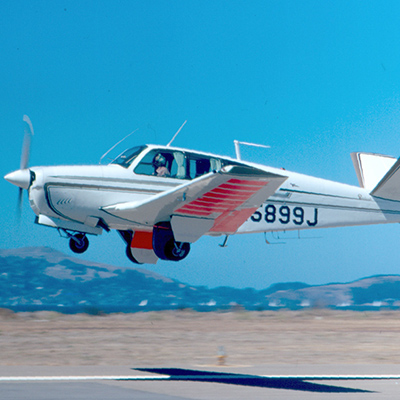Warfare
Bonanza
Mohsen Shir-Muhammad
103 Views
The F-33 aircraft, commonly known as the Bonanza, was one of the training planes used by the Iranian Army Air Force during the Iran–Iraq War. It was used for pilot training as well as aerial reconnaissance missions.
The Bonanza is a single-engine, training and liaison aircraft manufactured by the American company Beechcraft. The first model, known as the Bonanza F-33, made its first flight in 1970. Since then, more than 20 different models and around 17000 units have been produced. In addition to the pilot, it can carry up to five passengers. Its maximum speed is 326 km/h, with a service ceiling of 18500 feet (approximately 6150 meters) and a range of 409 kilometers. The maximum takeoff weight of the aircraft is 1656 kilograms, and it is 8.38 meters long.[1] Powered by a 285-horsepower engine, the Bonanza is mainly used for basic flight training. However, it takes on liaison, reconnaissance and transport duties. Bonanza joined the Iranian Air Force in 1973.[2]
After the Islamic Revolution, Iran stopped sending pilot cadets to the United States, and flight training began to be carried out domestically. In early 1979, twenty-one Air Force pilots volunteered to launch a new flight training program using the Bonanza at Qaleh-Morghi[3] Airport in Tehran.[4]
By October 1980, the Air Force had 22 Bonanza aircraft.[5] Each airbase had two stationed, and the rest were based at Qaleh-Morghi.[6]
When the war broke out, Bonanza was also used for aerial reconnaissance. On October 6, 1980, unarmed surveillance flights using Bonanza aircraft began from Qaleh-Morghi Airport. These flights would be carried out from sunrise to sunset to enhance radar coverage. In fact, setting up airborne observation posts proved to be a big help to the air defense network, especially in the northwestern, western, and central parts of the country.[7]
All Bonanza aircraft active in the National Aviation Club were handed over to the Air Force. At least two of these planes were stationed at each Air Force military base, flying daily surveillance missions roughly 50 to 60 miles out from the base in directions where enemy air attacks were likely. Their mission was to monitor for any enemy air movements towards bases, refineries, key facilities, or other sensitive sites and report them to local command centers.[8]
On October 7, 1980, the first Bonanza took off from the National Aviation Club (Qaleh-Morghi) on a reconnaissance mission.[9] Later that month, on October 21, the Bonanza F-33 conducted its first reconnaissance flight over Bandar Abbas and the Strait of Hormuz.[10]
During the war, the Air Force Self-Sufficiency Unit reverse-engineered the Bonanza aircraft.[11] In mid-1987, Iran started manufacturing a domestic version of the aircraft. Thanks to the efforts of Colonel Mansour Sattari (martyred), then-commander of the Iranian Army Air Force, the airframe was completed in early 1988,[12] and a Bonanza engine was installed on it.[13] The plane, named Parastoo, successfully made its first flight on April 5, 1988.[14]
Parastoo became the first piston-engine, two-seat aircraft produced by the Iranian Air Force to officially enter service and be used in training programs.[15]
Today, Iranian Air Force cadets are sent to the Qiyam Air Base (Koushk-e Nosrat, Qom) for their initial flight training, where they start flying with the Bonanza.[16] Maintenance and repair of the Parastoo fleet is handled by technicians of the Air Force Logistics Command Repair Center.[17]
[1] Babaei, Muhammad-Reza, Parandeh-haye Pouladin-e Iran (Iran’s Steel Birds), Vol. 3, Tehran, Sabz Rayan Gostar, 1394, p. 46.
[2] Zeinali, Nasrollah, Amad va Poshtebani-ye Havayi dar Defa Muqaddas (Air Force Logistics and Support Command in the Sacred Defense), Tehran, Markaz-e Entesharat-e Rahbordi-ye NAHAJA, 1394, p. 236.
[3] Khanbanpour, Mahdi, Parvaz-haye Tarabari-ye Havayi dar Jang va Bad az Jang (Air Transport Flights during and after the War), Sit-e Tarikh-e Shafahi-ye Iran, 18 Mordad 1396, www.oral-history.ir/?page=post&id=7238
[4] Mehrnia, Ahmad, Setareh-haye Nabard-e Havayi, Vol. 2 (Stars of the Air Battle), Tehran, Soore Mehr, 1390, p. 519.
[5] Zeinali, Nasrollah, Ibid., p. 278.
[6] Ibid., p. 265.
[7] Mousavi, Seyyed Esmaeil and Digaran, Taqvim-e Mostanad-e Amalkard-e Niru-ye Elahi-ye Havayi Artesh-e Jomhouri-ye Eslami-ye Iran, Vol. 3 (Documented Calendar of the Performance of Divine Iranian Army Air Force), Mehr 1359, Tehran, Markaz-e Entesharat-e Rahbordi-ye NAHAJA, 1397, Pp. 442–441.
[8] Ibid., p. 443.
[9] Ibid., p. 456.
[10] Ibid., p. 647.
[11] Asr-e Kabin-haye Digital dar NAHAJA; az T90 ta Yasin (The Era of Digital Cabins in NAHAJA; From T90 to Yasin), Khabargozari-ye Fars, 25 Mehr 1398, https://farsnews.ir/politics/1571312701000765125
[12] Akbar, Ali, Pakbaz Arseh-ye Eshq (The Loyalist of the Realm of Love), Tehran, Nashr-e AJA, 1375, Pp. 86–88.
[13] Hashemi, Ali-Reza, Karnameh va Khaterat-e Hashemi Rafsanjani – Payan-e Defa Aghaz-e Bazsazi (The Record and Memoirs of Hashemi Rafsanjani – The End of Defense, Beginning of Reconstruction), Sal 1367, Tehran, Daftar Nashr-e Maaref Enqelab, 1390, p. 64.
[14] Akbar, Ali, Ibid., Pp. 86–88.
[15] Asr-e Kabin-haye Digital dar NAHAJA; az T90 ta Yasin (The Era of Digital Cabins in NAHAJA; From T90 to Yasin), Ibid.
[16] Gozareshi az Paygah-e Shahid Babaei Esfahan (Report on Shahid Babaei Base, Isfahan), Vizhehname-ye Electroniki-ye Rouz-e Artesh va Hamaase-Afarini-haye Niru-ye Zamin, Portal-e Artesh, https://www.aja.ir/portal/home/?PAPER/71464/71646/1701079/
[17] Yek Farvand-e Havapimaye Parastoo 14 be Navgan-e Parvazi-ye Niru-ye Havayi Artesh Molhaq Shod (A Parastoo-14 Aircraft Joined the Air Force Fleet), Khabargozari-ye Fars, 13 Shahrivar 1392, www.farsnews.ir/news/13920613000946





